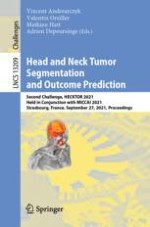2022 | Buch
Head and Neck Tumor Segmentation and Outcome Prediction
Second Challenge, HECKTOR 2021, Held in Conjunction with MICCAI 2021, Strasbourg, France, September 27, 2021, Proceedings
herausgegeben von: Vincent Andrearczyk, Valentin Oreiller, Mathieu Hatt, Adrien Depeursinge
Verlag: Springer International Publishing
Buchreihe : Lecture Notes in Computer Science
